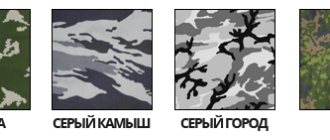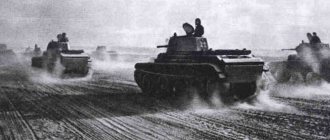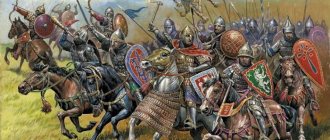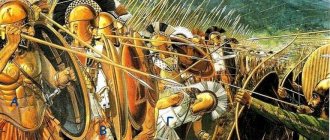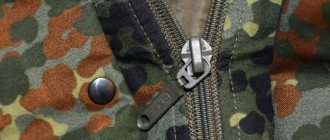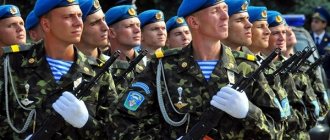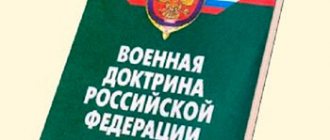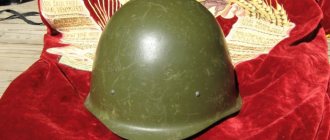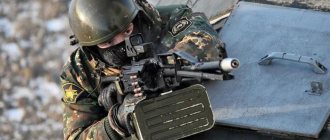Camouflage (from the French camouflage - “camouflage”) is a camouflage coloring used to reduce the visibility of personnel, weapons, military equipment and structures by breaking up silhouettes or objects.
Today, camouflage colors are used not only in the ranks of active military units, but also in everyday life. Tourists and hunters also wear protective clothing so as not to stand out in natural conditions.
Camouflage color in military service
Field military uniforms began to be purposefully sewn from fabrics of protective camouflage colors at the end of the 19th century. Thus, by the end of the 19th century, British colonial troops in India adopted the color “khaki,” which translated from Persian means “color of dust.” The khaki military uniform performed well on the battlefields of South Africa. Then the rest of the world’s armies, including Russian ones, began to use it. They met the First World War already in it.
Later in 1909, the American artist Abbott Thayer published the book “Color in the Animal Kingdom.” Much of what was described in it formed the basis of the theory of scientific mimicry, after which the development of camouflage principles for the military began.
During World War I, British artist and naval officer Norman Wilkinson developed a special camouflage scheme for the navy, the so-called “blinding camouflage” (or “deforming camouflage”). Such a gray color did not hide the ships, but made it difficult to calculate the distances to them, as well as courses and speeds.
In 1939, French artist Vladimir Baranov-Rossinet patented a spotted military uniform called "pointillist-dynamic camouflage" or "chameleon method".
It should be borne in mind that most of the concepts of army camouflages were developed for the specific terrain in which the military was located. At the same time, the regulatory requirements for camouflage in open areas were taken into account. The studies were carried out during daylight hours. As a result, many armies of the world decided to use camouflage patterns in the production of military equipment to save personnel during combat clashes.
And already in the Second World War, camouflages were used by all branches of the military, depending on the geographical features of the places of expected battles. They used camouflage suits with uneven spots (in the form of amoebas) in brown or black colors on a green khaki background. In the USSR, they actively used winter camouflage - white camouflage coats worn over outerwear. A year before the end of the war, camouflage overalls appeared in light green colors with dirty gray patterns imitating leaves, or with patterns reminiscent of current “digital” camouflages.
History of camouflage: Soviet fleet
The first examples of camouflage painting on warships can be found during the Crimean War, when the gunboats of the Imperial Russian Navy on the Baltic Sea began to be painted blue-gray so that from a distance they resembled skerries. Gradually this practice was forgotten and came back to life only in the twentieth century. Our colleagues from the portal worldofwarships.ru talk about the return of ship camouflage in the Soviet fleet on the eve of and during the Great Patriotic War.
In the pre-war period in the Soviet Navy, camouflage was the exception rather than the rule. However, you can find some pretty interesting paint schemes that have remained on ships since the First World War - for example, the “fragmentation” camouflage of the destroyer “Lenin” or the “blinding” camouflage of the destroyer “Rykov”.
At the same time, the main part of the fleet's ships were painted according to a single standard - a uniform spherical (gray) color. The leader of the destroyers “Tashkent” had an original appearance, retaining its factory Italian coloring - for its spherical color with a bluish tint it received the nicknames “blue cruiser” and “blue handsome”.
With the outbreak of World War II, complex paint schemes began to be used. During this period, in addition to the already classic spherical coloration, Soviet ships used various camouflage schemes - both borrowed from the allies and developed independently.
In the Black Sea Fleet, along with conventional oil paints, the so-called silver paint was used - paint based on aluminum powder. It reflected the color of the water, and the areas covered with it changed shades depending on the weather and lighting, which made this coloring universal. This is how the cruiser Molotov and the Komintern, a former armored cruiser of the Russian Imperial Navy converted into a minelayer, were painted. The Pacific Fleet light cruisers Kalinin and Lazar Kaganovich received similar paint schemes.
Several ships on the Black Sea received a complex paint scheme with “shading” - a smooth transition from dark to light. The destroyers Bodriy and Soobrazitelny received this coloring. The ships of the Northern Fleet were close in camouflage schemes to the British ships, which simplified visual identification when escorting convoys. At the beginning of the war, the destroyer "Gremyashchiy" was one of the first to receive camouflage painting, which combined elements of "blinding" camouflage with spots and colors close to those used on Allied ships.
The underwater part of ships was covered in several ways. In addition to the red lead common in many fleets, “Kuzbass-varnish” was used - a special solution of varnish bitumen, which, when applied, formed a glossy coating of black or black-brown color, resistant to atmospheric influences, while protecting the surface from corrosion and fungi. Another painting method was the anti-fouling composition “International” in dark red and green colors, which had similar characteristics to the previous one.
Submarines were also painted in ball colors in various shades from light gray to dark gray. The submarines could be either completely plain or with the waterline and underwater part painted in the colors of the anti-corrosion coating.
Cargo and support vessels were often painted in complex camouflage schemes. In addition to camouflage painting, “decorative camouflage” was widely used using various additional elements imitating coastal buildings or even enemy ships. For example, several small hunters of the Black Sea Fleet were disguised as German boats.
During the siege of Leningrad, the ships of the Baltic Fleet received special camouflage to make visual detection difficult by German military intelligence and, if possible, to protect the ships from shelling. In particular, through the efforts of the artist Boris Smirnov, many warships turned into barracks, piles of garbage, or even part of the embankment for the enemy.
Klim Zhukov
/
Cubism on armor
The history of naval camouflage in photographs: from World War I to the present day
- fleet
- photos
Warspot Editorial
/
Lecture on the art of camouflage
Animated film - Private Snafu talks about the ability to disguise himself
- WWII
- art and creativity
- USA
- propaganda
Alexey Gruzdev
/
Hide your guns!
Summer and winter camouflage painting of the Red Army artillery 1941-1942.
- WWII
- artillery
- USSR
- modeling
American types of camouflage
In the post-war period, military camouflage was practically not studied, but in the fifties of the 20th century, due to military operations in Southeast Asia, camouflage camouflage became interested again. So, for the American army at that time they began to sew 43 camouflage kits of the following types: “desert”, “forest”, “jungle”, “winter” and others.
The Americans used Duck Hunter camouflage before the Vietnam War. It was used by the 2nd Armored Division during Operation Cobra. However, due to the frequent use of fire on friendly units, it was canceled, limiting it to branches or leaves attached to helmets.
Modern camouflages: principles of creation, varieties, prospects. Part 1
Modern camouflages: principles of creation, varieties, prospects
Part 1. General principles. Russian camouflages
Almost all modern armies are supplied with uniforms intended for use directly on the battlefield - field uniforms. Most armies in the world have this uniform in camouflage coloring. This material provides an overview of the main camouflage colors currently used in various armies of the world.
It should also be noted that this material does not discuss the cut of uniforms, the quality characteristics of the fabric, and similar issues. The subject of consideration is exclusively the texture and color scheme used in camouflage.
Let me make a reservation right away that the material does not cover everything, but only the main and most common camouflages; the topic of camouflages of the 1940s and earlier camouflages (of which there were quite a lot) is also not disclosed; the topic of special (for example, urban, “hunting” or winter) colors is also not touched upon, since it is not possible to cover this entire volume within one material in the format of an article.
Basics of Camouflage Pattern Construction
Camouflage, or camouflage colors, serves the purpose of camouflaging the object on which it is applied. In this case, camouflage means reducing the contrast visibility of an object in the optical range in order to make it difficult to identify the object. To achieve this goal, camouflage has two functions: 1. The deforming function of camouflage is a violation of the integrity of the perception of an object. 2. The imitation function of camouflage is the inseparability of the object from the background.
The deforming function is implemented in modern camouflages primarily by breaking the silhouette of an object into a number of contrasting color spots. Imitation is implemented through the use of a color scheme similar to that characteristic of the area where camouflage is supposed to be used, and in an optimal form - through the imitation of natural objects (leaves, grass, areas of tree bark, stones, etc.), characteristic of of this area.
Rice. 1. Illustration of the operation of the camouflage simulation function. Hunting camouflage
Rice. 2. Illustration of the action of the deforming function of camouflage. Camouflage A-Tax
The difficulty of creating effective camouflage is that when implementing the first function, it is optimal to use large color spots (they break up the silhouette better, since they do not “merge” into a single color at medium and long distances), and when implementing the second function, it is optimal to use image of static natural objects on a scale of 1:1, that is, as a rule, small leaves, grass stems, etc. This creates a contradiction that different developers solve in different ways. For example, in “hunting” types of camouflages, the deforming function is completely sacrificed to the imitation function - usually “hunting” camouflages represent a full-scale image of those natural objects where hunting is expected. In the Russian “Gorka” (its classic version), on the contrary, the imitation function is expressed much weaker than the deforming one: the imitation function consists only of the use of appropriate colors, while the deforming one is implemented in the form of the use of large-area overlay elements.
A few words about the colors of camouflage schemes. There are two general requirements for colors used in creating camouflages:
1. The color must match the dominant/frequently occurring color in the area where the camouflage is intended to be used. 2. The color should be “unpleasant” to the human eye; the gaze should not intuitively stop at an object of that color.
That is why camouflage colors usually use dull, faded light brown, moderate gray and dark green colors; at the same time, for example, the light green color, although common in nature, is poorly suited for use in camouflage due to its brightness. The most commonly used colors in camouflage are: khaki, olive, marsh, dark and light brown, gray, black.
Brief history of the issue
Before the advent of mass-produced hand-held firearms that were effective at considerable distances, the task of visually concealing one’s troops was less relevant than the opposite task—good visibility of one’s troops for a military leader. Due to the extremely limited means of tactical communication (in fact, there were no other means of communication except messengers), it was vital for the commander to observe the disposition and maneuver of his own troops, which is why it seemed advisable for these troops to use bright uniforms that were visible at a considerable distance. Often these uniforms had the colors of the national flags in one combination or another, and also differed in color among different units. The task of camouflaging individual soldiers was not highly relevant, because the main type of combat remained hand-to-hand; fire contact took place at an insignificant distance, at which the enemy soldier was visible regardless of the color of his uniform. In addition, the use of linear tactics and linear infantry formation made it absolutely pointless to use any camouflage clothing (it is difficult not to notice a dense line of 50 soldiers along the front at shotgun range, even if they were dressed in the most effective camouflage).
However, even in the era of the dominance of smooth-bore weapons and linear tactics, camouflage was still used by individual units, primarily by huntsmen. The tactics of the rangers were somewhat similar to the tactics of modern infantry units (loose formation, use of natural shelters), and their weapons (rifled guns with an effective range of up to 200-250 m.) made it possible to fire beyond the reach of enemy line infantry fire - but in the event of an attack the enemy's linear infantry (and even more so cavalry), the rangers were doomed. In addition, the rangers were vulnerable to fire from the same rangers from the “other” side. That is why it was among the rangers that the first developments appeared, designed to reduce the visual visibility of the shooter - one might say, the first camouflage. In all European armies, chasseurs, unlike line infantry, wore black, dark green and dark gray uniforms, and their headdresses did not have decorations or clearly visible emblems. Suvorov's instructions are widely known, instructing rangers to use plucked tree branches with leaves to enhance camouflage - a technique that works well in our time.
The situation with uniforms changed when, in the middle of the 19th century, rapid-fire rifled small arms began to enter service en masse, increasing the range of fire contact several times. It is generally accepted that the British were the first to move from the concept of a bright uniform to the concept of visual invisibility of a soldier during the Anglo-Boer War, because The bright red uniforms of the British were an excellent target for the Boer riflemen (who wore civilian clothes in dull “Protestant” shades). It was then that the British adopted a khaki-colored uniform for supply (khaki in Hindi means “dusty-earthy”), and seriously reduced the visibility of their soldiers. However, this version hardly withstands factual criticism, because dark green uniforms without decorations appeared in the army of the Russian Empire as a field uniform 10 years before the British encountered the Boers.
However, most European armies changed into uniforms of “protective” shades precisely in the second half of the 19th century and precisely taking into account the English experience. Research has been conducted in several countries to determine the most suitable and versatile camouflage color. The results, however, were different: Russia, England and Japan dressed the soldiers in khaki, France and Austria-Hungary - in sky blue, and Germany - in dark gray. These countries took part in the First World War in such uniforms.
At the same time, during the First World War, the first spotted camouflage of the modern type appeared. It became the German “fragmented camouflage”, so named because of the broken lines that delimit the color spots. Initially, this camouflage was used only on helmets, and these were not fabric covers, but simply paint applied to the metal of the helmet.
Camouflage received further development during the Second World War, and this time in its modern form - as the coloring of field uniforms. Initially, only samples of special shapes were produced camouflaged, i.e. camouflage suits and capes; however, by 1944, regular camouflage uniforms also appeared. The largest number of camouflage options during WWII appeared in the USSR and Germany, and in the USSR they emphasized the use of special sniper raincoats and camouflage overalls, and in Germany - directly on the uniforms of military personnel (mainly camouflage uniforms in Germany were worn by units of SS field units) .
The main development of camouflage colors of field uniforms was already in the post-war years, especially from the 1970s to the present. It is modern camouflages that will become the main subject of consideration in this article.
Modern camouflages of Russia
In this material, modern Russian camouflages mean not only those samples that are in production and supplied to the Armed Forces and other law enforcement agencies of the Russian Federation, but also those that are actively used by military personnel and employees of other law enforcement agencies. Among these camouflages, technically, there are camouflages created in the USSR - within the framework of this material they are classified as “Russia”. Foreign-designed camouflages, also actively used by Russian security forces, are discussed in sections dedicated to the relevant countries.
KZS/Coloring-57
Historically, the first modern camouflage can be called a color scheme that has several names, the most common of which is “KZS”. It should be noted that KZS stands for “protective mesh suit”, and is not the name of the color, but the name of the product painted in this color. It is believed that the official name of the camouflage is “1957 pattern”, but this name is used quite rarely. Sometimes this color is unofficially called “Birch”, but such a name cannot serve as a unique name, because “Berezka” is also unofficially called another camouflage - VSR-93. Also, this coloring is sometimes called “border camouflage”, because... For a long time it was supplied exclusively to the Border Troops of the KGB of the USSR.
Rice. 3. Color arr. 1957 (KZS), “Silver Leaf” option
This coloring exists in two variants while maintaining the same textural scheme: in one of the variants, the small spots have a gray-silver color, in the other (it was the one that was supplied to the border troops) - sand or khaki. The background color of both variants is olive; sometimes there are swamp-colored specimens. In any case, the background in this color scheme is always darker than the spots. The spots themselves have an “angular” structure, consisting of many squares.
It should be noted that this color scheme, although considered “morally outdated” by some experts, performs both functions quite well - deforming and imitation.
Rice. 4. Fighter in the KZS on the ground
"Butane"
This camouflage was developed in the USSR in the 1980s as the main pattern for field uniforms. Despite the production of a significant number of products from it, it was not particularly widespread among the troops, although it was quite effective. Currently found in the Russian Aerospace Forces and the Armed Forces of Ukraine (in Ukraine for a long time it was the main camouflage), but in both cases it is being actively removed from supply, being replaced by other models.
Rice. 5. “Bhutan” camouflage
Other names for this camouflage are “Oak” and “Amoeba”, and “Amoeba” is also the name of one of the camouflages from the Second World War. The colors themselves can vary, only the scheme remains unchanged: a light green background, dark green spots and light brown amoeba-shaped intersecting ribbons.
In the 1990s, in many parts of the RF Armed Forces there was a situation where officers wore “Butan”, and privates and non-commissioned officers wore VSR-93, so in the 1990s this camouflage was sometimes called “officer.”
VSR-93
Developed in the early 1990s, accepted for supply in 1993, replacing the ubiquitous khaki Afghan. When creating this camouflage, the experience of WWII camouflages, in particular, a number of German camouflages, was taken into account.
Rice. 6. VSR-93
Quite often unofficially called “Berezka”, just like KZS. It was believed that the semi-official name of the VSR-93 was “Barvikha”, but this name does not appear in official documents. Also sometimes called "Watermelon" (or "Vertical Watermelon"), however "Watermelon" also applies to the VSR-98.
According to reviews of those wearing a uniform of this color, it is “very good to lie in,” because longitudinal spots very effectively imitate grass vegetation. However, camouflage, according to experts, is too highly specialized and is not universal and applicable to any terrain. In addition, there is information that this type of color “created an unsightly appearance for military personnel at parades,” so in 1998, products of this color were removed from supply.
VSR-98 "Flora"
Accepted for supply to the RF Armed Forces as the main one in 1998, it replaced the VSR-93. When developing this camouflage, the results of a study of the dynamic efficiency of camouflage were taken into account, that is, the ability of camouflage not to lose its functions when an object moves. According to the study, horizontal stripes help maintain camouflage functions when an object moves, while vertical stripes, on the contrary, unmask when moving.
Unlike previous camouflages, VSR-98 has not only a digital code, but also an official name - “Flora”, but unofficially, like VSR-93, it was called “Watermelon” or “Horizontal Watermelon” in the army.
Rice. 7. VSR-98 “Flora”
There is a Flora color scheme in which the background is not light green, but dark yellow, sand or khaki. Such color schemes were popular among the troops of the North Caucasian Federal District, where the grass fades already in June and, accordingly, remains yellowish throughout the summer. Officially, "Flora" was withdrawn from supply in 2009 (according to other sources, in 2011), giving way to a more modern color scheme.
EMR/ZDU/Ruspat/Russian figure/Russian pixel
This camouflage appeared in 2008 (accepted for supply a year later), after a fundamental decision was made to change the “Flora”. Initially, it was assumed that since “Flora” roughly corresponds to the American “Woodland”, which in the US Armed Forces is actively changing to “digital” camouflages (see below), then the Russian Armed Forces should keep up with this process. The creation of the EMR was actively influenced by the German camouflage “Flektarn”, the developers of which managed to “combine the incompatible”: small spots that perform an imitation function are combined in this color scheme so that they form groups of large spots that perform a deforming function. The developers of EMP followed the same path, taking into account the results of studies that showed the effectiveness of extremely small (“pixel”) spots as constituent elements of a texture pattern (see derivatives from “Marpat”). The result was "EMP".
Rice. 8. EMP in two colors
The name “EMR” stands for “Unified Camouflage Pattern” - this is the name under which this camouflage is supplied to the RF Armed Forces. However, it is known that the first manufacturer of products with this color gave it the name “ZDU” - “protection to the limit.” In the West, this camouflage is known as “Ruspat” (Russian Pattern) by analogy with the American patterns. Also unofficially, this camouflage is called “Russian Number”, “Russian Pixel” or (in military usage) simply “Pixel”. Currently, EMR is the main camouflage used by the Russian Armed Forces. Interestingly, it is also supplied to the Belarusian Armed Forces, but it is believed that the Belarusian version of the EMR has a slightly different color scheme.
"Undergrowth"
Created in the early 1990s at the St. Petersburg NPO Spetsmaterialy as an alternative to the VSR-93 for adoption by the Ministry of Internal Affairs. When creating it, the same principles were followed as in VSR-93, however, the vertical stripes were made more angular, the brown color was replaced by black, and the base was made lighter than in VSR-93. When creating “Undergrowth”, it was taken into account that vertical stripes visually increase the height of a person in such camouflage, which is relevant for the Ministry of Internal Affairs, because an employee in such a uniform has an additional psychological impact on detainees.
Rice. 9. "Undergrowth"
Officially it was supplied to the Ministry of Internal Affairs and was actively used by various units of the Special Forces.
"Raster undergrowth"/"Raster"
It was created at the same NPO “Special Materials”. It represents the first “dual-frequency” camouflage pattern in the practice of creating camouflage colors. The fact is that the original “Undergrowth” had a good imitation, but rather weak deforming effect, and therefore, when creating its improved version (“Rastra”), a twisted brown mesh network was applied in a special way to the original “Undergrowth” - it turned out to be a “double camouflage" or "camouflage on camouflage".
Fig. 10. "Raster undergrowth"
As a result, the original drawing of the “Undergrowth” is perceived by the eye as if at one frequency, and the superimposed “raster” network - at another, which contributes to the impossibility of intuitive perception of a person in such camouflage as an integral object. There is even a common rumor that if you just walk down the street in “Rastra”, you will not attract anyone’s attention - the gaze of passers-by will simply slide past. This discovery of Special Materials specialists was subsequently used by the Americans to create a series of Cryptek camouflages, but more on that below.
Another name for “Rastra” is “Pheasant”, but it is used for products produced in this color not directly by NPO Spetsmaterialy, but by other manufacturers. Raster camouflage is also officially supplied to the Ministry of Internal Affairs. For some unknown reason, however, it was not widely used.
"Tiger" / "Reed"
Strictly speaking, this camouflage, although produced in the Russian Federation on an industrial scale by various companies and, moreover, is widely used in various law enforcement agencies, is not a Russian development - it is rather an “adaptation” of an existing foreign camouflage (originally the Malaysian commercial Tiger Stripe) to Russian conditions.
Rice. 11. “Tiger” camouflage of one of the Russian variants
The color scheme, traditionally for Russian camouflages, can be changed by turning the light green base into sand or khaki.
If the “Tiger” was the result of a deliberate alteration of an existing foreign analogue, then the “Kamysh” appeared due to an accident when the manufacturer mistakenly sewed the uniform so that the stripes of the “Tiger” turned out to be vertical. However, the classic “Tiger” is often called “Kamysh”.
Officially it was never in supply, unofficially it is used by all law enforcement agencies, although now its popularity is falling due to the advent of more effective colors.
"Partisan"
Commercial camouflage, not officially available anywhere. Unofficially, it is very popular, especially in the North Caucasus Federal District, where its yellow-brown deforming stripes are very relevant against the backdrop of grass that has been scorched for most of the warm season. Created under the influence of German camouflages from WWII (almost exactly copies one of them), that is why it is called “Partisan” - because, as far as we know, initially its creators, without particularly “bothering” with coming up with a name, planned to call it “SS camouflage” "
Rice. 12. Camouflage “Partisan”
In the European part of Russia, this camouflage is very effective in August-September. The rest of the time it has an excellent deforming, but controversial imitation function.
"Kink" / "Chip"
Another commercial camouflage, unofficially not in supply, but very actively used in various law enforcement agencies. It is known that a number of units (not units, but units) of the Special Forces, both army and explosives, prefer the uniform of this particular color.
Fig. 13. Camouflage "Kink"
When creating “Kink,” the experience of “Flektarn” was used, as in the case of EMR. It is interesting that “Kink” has such a specific location and color combination of spots that it creates the illusion of three-dimensionality of smooth fabric, and, accordingly, has a very good deformation effect. Unlike most Russian camouflages, Izlom does not allow the use of colors other than the original ones. As with Partizan, it is believed that this camouflage is effective mainly in August and September.
Surpat
Developed by a Russian company at the request of employees of special forces units. It is an adaptation of the American “pattern” scheme to Russian conditions.
Rice. 14. Surpat
Unlike the original (American “pattern” camouflages), Surpat uses light gray as a base; the location of the spots has been changed; brown and green colors are as close as possible to the color scheme characteristic of the Russian landscape. Despite this, it is distinguished by significant versatility in relation to terrain - tests conducted by Survival Corps itself showed Surpat’s performance in almost any natural area.
There is no official information about the use of Surpat in any units of the Armed Forces or the Ministry of Internal Affairs of the Russian Federation, but sometimes on documentary materials you can see military personnel in this camouflage.
Range
Another adaptation of “patterns” to Russian conditions. It has slightly less versatility compared to Surpat, however, in comparison with it, it has a slightly better imitation effect in forest landscape conditions.
Rice. 15. Spectrum
There is also a “Spectrum-SKFO” version, where the color scheme is adjusted towards “yellowness”. Unlike Surpat, it is widely produced by several manufacturers. It is interesting that it was “Spectrum” that was personally used by I. Strelkov and his unit.
Dusk
Initially created as a hunting, exclusively commercial camouflage. Like most hunting camouflages, it was intended for very narrow conditions: rocky surface with moss, morning and evening time of day. However, it unexpectedly turned out that this camouflage performs quite well in a much wider range of conditions than those for which it was created, which is why it has become very widespread.
Fig. 16. Dusk
It is not officially employed anywhere in the supply chain, but is unofficially used by some departments and individual employees. Russian companies also produce a wide range of Western-designed camouflages, but they will be discussed in the sections of the countries where they were created.
The next part of the material will be devoted to the consideration of camouflages of Anglo-Saxon countries.
Modern pixel camouflage
Since 1984, they began to use camouflage called “digital”. This camouflage coloring is similar to the pixels of monitor screens. Such patterns prevent the eyes from fixating on objects, causing them to be perceived as “white noise”, and by analogy with blinding camouflage, this interferes with the determination of shapes and speed of movement.
Previously, countries had different approaches to camouflage uniforms; today there is a general tendency for armies to have one universal pattern. Refinement is carried out only taking into account different types of terrain. Thus, ACUPAT camouflages are available in different colors (such as “desert”, “urban” and “forest”, or the basic “urban” - urban gray version), Flektarn, DPM and others.
Sometimes individual army units may have their own pattern, but even in such cases the same trends are noticeable. For example, the MARPAT used by the American Marines, although different from the uniform ACUPAT patterns used by other units, also has several color schemes. They are used to suit the terrain and are the basic "woodland" field camouflage - a forest pattern with green and brown tones.
Soviet military uniform (camouflage) Bhutan
I won’t tell you, my readers, about the history of the emergence of camouflage in the world and in the USSR in particular. Today's article is about what, in my opinion, is the best camouflage pattern created for the Soviet Army - butane. So what is butane? Dahl's dictionary interprets it as a hill, an embankment in a field dug up by field marmots (babaks or boibaks, called differently). Apparently, that stinking gas, often transported in railway tanks, got its name from that, because it smelled like butane.
The developers of the drawing assumed that it would look like a completely natural landscape of a temperate climate, which is similar to the appearance of this very butane. That’s why it can be used almost throughout the entire territory of the USSR. It is worth clarifying that the established name “Butan” is the name of the project to create a camouflage pattern. There were also “Barvikha”, “Palekh”, perhaps some others that we do not know about.
After the reform of 1959, the main camouflage pattern (also called “lump”) was the well-known “birch”. By the way, looking at it, we can say with confidence: digital camouflage was created precisely in the Soviet Union.
For the first time, butane entered service with the army under the marking VSR-84 in 1984 for marine and airborne units. Somewhat later it was adopted by the Air Force; in particular, such lumps were issued to helicopter pilots. It is worth noting that the Russian Air Force still uses it.
There is unconfirmed information that initially butane “lumps” were made in Czechoslovakia and the GDR, and there was even a popular name - Czech oak (maybe that’s why they call it that in Ukraine now) - and the dyes were from India. Also, due to its similarity with the colors of the armies of the Warsaw Pact countries, butane was sometimes called “Warsaw”. It is worth clarifying that butane camouflage was made from fabrics with article numbers Yu19D, Yu32D, Yu42D, 3221, 3225. Since 1991, the production of uniforms from fabric C3310A (popularly “glass”) began for the airborne troops.
At flea markets you can now still find offers to sell similar products produced in the USSR.
In addition to the Air Force, in the Russian Federation this camouflage pattern was used in many branches of the military until 1993, until it was replaced by the VSR-93 camouflage pattern developed back in the USSR, but introduced only then (the assumption that this is the “Russian Armed Forces” I think will be not true) or, as people call it, “vertical”. The “vertical” camouflage itself did not last long and was supplanted in 1998 by the newly introduced VSR-98 camouflage - the well-known “horizontal” or “flora”, which is still used today, gradually being replaced by “digital flora” in connection with military reform.
In independent Ukraine, such camouflage continued to be used in the “Zbroiny Forces” of Ukraine since their formation in 1992 in the above branches of the military. Since 1996, butane has been used as a combined arms camouflage (over-arms) in all branches and branches of the armed forces. It should be noted that until 2000, although the field uniform was sewn already in the 90s, as evidenced by the stamps on the left side of the inner lining of the jacket, it was still sewn from that old cotton Soviet fabric: it was stored in abundance in warehouses as an emergency reserve.
The quality of the design of the Soviet design (Butan-B) and Ukrainian (Dubok) is visible to the naked eye
Upon exhaustion of stocks of high-quality cotton fabric (“khabeshka”), the independent Ukrainian industry began to weave new “high-quality” fabric with zeal. As one friend put it, the quality of Ukrainian fabric is “beyond good and evil.” The drawing, at first glance, has not changed at all. But taking a closer look, we will notice that the stains “run over” one another, are done carelessly, just how, and the fabric itself leaves much to be desired. It became semi (or maybe completely) synthetic, the so-called “glass”, “wafer” (due to the similarity of the relief with the food product of the same name). And the colors changed to a brighter one (is this in disguise?!), which, “fortunately,” quickly faded and faded, resembling flabby, shapeless burlap. And the military personnel, no longer knowing the origin of this camouflage, began to call it “zagalnovyskova” or simply “oak”.
Author of the material: Kolesnikov A.V.
Camouflages of Russia and the Soviet Union
Digital Russian camouflage is currently considered to be “digital flora”. In Western qualifications, this camouflage is called Russian Pattern, and in the army environment it is known as “Pixel”. This camouflage was developed in 2008, and was accepted for supply and the Ministry of Internal Affairs a year later, after they made the fundamental decision to replace Flora.
Over the years of history from the Soviet Union to modern Russia, the following types of camouflage have been developed for the army:
- "Amoeba". Camouflage pattern 1935. Manufactured in several versions;
- "Deciduous Forest" model 1942;
- "Palm". Deforming pattern from 1944. Produced in four versions according to the seasons;
- "Silver leaf" model 1957. It was also called “Birch” or “sunny bunnies”, as well as the camouflage of border guards;
- “Butane”, which has another name “Oak”. Was developed in 1984;
- Russian camouflage pattern of 1993 – VSR-93, also called “vertical”;
- Russian camouflage pattern of 1998 - VSR-98 Flora. This has been the main Russian combined arms camouflage pattern since 1998. Despite its low attractiveness, this type of camouflage did a very good job of camouflaging military personnel in the areas of the Russian central zone. Possessing some characteristic stripes, “Flora” received the nickname “watermelon” camouflage. It was produced in three versions;
- Digital Russian camouflage. “Digital Flora” is currently the new pixel camouflage in the Russian Armed Forces.
In addition, there are commercial types of camouflage, such as:
- "Tiger". Green-brown horizontal stains;
- "Reeds". Sandy-brown color imitating reeds;
- "Partisan". Green form with yellow spots;
- "Kink." Three-color deciduous forest imitation;
- "Skol." Dark version of green camouflage;
- "Surpat". Pixel camouflage for different terrains;
- "Range". Dominant color green;
- "Dusk". Suit with gray splashes, suitable for urban environments.
Most of these types of camouflages are not officially supplied anywhere. However, they have found unofficial use in certain departments and among individual employees. Specialized Russian companies continue to produce a wide range of camouflage workwear developed by Western companies. In addition, modern Russian military science and industry do not stand still, all the time improving the protective functions of the suits currently available, as well as developing more and more new types of camouflages that would fully meet the new realities.
Why weren't Soviet soldiers dressed in camouflage on the battlefields?
If you look at the soldiers of different armies of the Second World War, for example, soldiers of the Red Army and the Wehrmacht, you get the impression that camouflage did not exist in those days. In fact, there was camouflage, but ordinary soldiers most often did not have it. The reason for this situation was not at all that the “bloody command” wanted to “put” as many men on the field as possible
The soldiers did not have camouflage. |Photo: widelec.org.
In fact, the statement that soldiers did not use camouflage during World War II is completely incorrect. Camouflage uniforms and equipment were used in all armies of the world, including the Red Army and the Wehrmacht of Nazi Germany. However, the prevalence of camouflage uniforms was much lower than in modern armies, where almost all military personnel are dressed in camouflage in one way or another. There were reasons for this, primarily production ones.
No need for infantry. |Photo: berghofday.blogspot.com.
In fact, the first camouflage uniform appeared before the First World War. After it, camouflage began to actively develop. Many universities around the world have been researching colors and patterns for military uniforms. However, the production of camouflage remained a relatively complex process in those days.
Camouflage robes were worn by scouts. |Photo: myhistori.ru.
Moreover, the field uniform of green, earthen, sand and gray colors, which was used in the ground forces of different countries, fully met the necessary requirements of the troops in the field of camouflage in the existing realities of combat operations. In most cases, camouflage uniforms were reserved only for specialist units.
In winter, white coats were worn over the uniform. |Photo: chert-poberi.ru.
In the Soviet Union, camouflage and camouflage capes were worn by sappers, snipers, fighters of reconnaissance and sabotage units, as well as border troops. The most common type of camouflage at the start of the war was Amoeba, developed back in 1935. This one was available in the colors “summer”, “spring-autumn”, “desert”, “mountains”. In winter, the army used white camouflage robes.
B, on the right is “Deciduous Forest”, on the left is “Palm Tree”. |Photo: gearguide.ru.
In 1942, the Red Army introduced a new camouflage suit, “Deciduous Forest,” and in 1944, “Palma.” The latter was available in four colors for each season of the year. Such robes were worn mainly by scouts, snipers and sappers.
The Germans had a camouflage cape. |Photo: reibert.info.
The situation was similar in Germany. The first Splittertarnmuster camouflage pattern was adopted back in 1931. The most popular element of the camouflage uniform was the Zeltbahn - 31 cape, which was widely used by the German troops. In 1938, a camouflage suit and helmet cover for snipers was developed in Germany. They were used throughout the war.
Camouflage was mainly used by the Waffen-SS. |Photo: szh-odal.org.
The most widely used camouflage in Germany was not the Wehrmacht at all, but the Waffen-SS units. The best camouflage uniforms in Germany were developed for the fighters of these formations. At the same time, the Reich command assumed (at the beginning of the war) that by 1945 all troops would be dressed in camouflage uniforms. However, in essence, camouflage in Germany was worn by the same “specialists”: snipers, reconnaissance saboteurs, paratroopers, sappers, anti-partisan formations.
Even snipers did not always have camouflage; they often limited themselves to a helmet cover. ¦Photo: ebay.com.
Serious restrictions on the production of camouflage in Germany throughout the war were imposed by the supply of high-quality cotton fabric. Relative to the demands of the SS and the Wehrmacht, they were critically small throughout the Second World War. In 1943, cotton stopped coming to Germany altogether, as a result of which the production of camouflage had to be transferred to the use of cotton fabric.
Camouflage began to be widely used throughout the world only in the 1960s, when industrial production had reached the required level of development for the mass production of such a uniform, and the style of warfare had finally moved away from what we were used to seeing in the First and Second World Wars.
Use of camouflage by paramilitary organizations
A wide variety of legal and illegal paramilitary groups from different countries use camouflages in uniforms and other types of clothing, equipment, and for painting vehicles. In our country there are also many such paramilitary or police organizations and formations. For example, camouflage is widely used by intelligence services, special forces, the well-known riot police, federal law enforcement agencies, as well as private security agencies.
Camouflage suits in everyday life
In the 1960s, camouflage became widespread in American civilian clothing as a civil protest against the war. Young people in military uniform on the city streets tried to make the townspeople feel what it was like when there were street battles and soldiers walking on your streets. This trend quickly passed, but was resurrected in the 1980s and gained unprecedented popularity already in the 1990s during Operation Desert Storm.
The fashion industry began producing pseudo-war paint, but using softer materials. Many famous fashion designers of that time approached the camouflage cut in different ways. They began to transfer elements of military uniforms even to women's skirts and dresses. Camouflage has become an integral part of sportswear.
The fashion industry began to produce:
- Women's camouflage;
- Urban camouflage;
- Green camouflage;
- Pink camo;
- Fashionable camouflage pants;
- Camouflage pants and jeans;
- And even camouflage workwear.
It is clear that winter camouflage and summer camouflage have begun to enjoy considerable popularity among people leading an active lifestyle. Hunters, fishermen, black diggers, as well as many tourists began to stock up on comfortable clothing in special colors. Colors that imitate wild African fauna, such as leopard or zebra, have become fashionable.
Camouflage and equipment of the Soviet Army
Camouflage uniform
In the last decades of its existence, the Soviet Union used several types of camouflage. The pattern and color of camouflage fabric was standardized in the 60s: irregular patches of medium green on a khaki background. The most typical type of camouflage clothing was KLMK, a camouflage summer camouflage overalls. In addition to camouflage overalls, snipers were given a face mask made of the same camouflage fabric. In the 80s, an attempt was made to dress border guards in camouflage field uniforms. In 1985, the appearance of KLMK with a new camouflage pattern was noted in airborne units. In winter, white camouflage coats were used, which were worn over clothing.
Equipment
The soldiers of the Soviet Army had much simpler equipment than their colleagues in the armies of NATO countries. The basis of field equipment: a belt made of leatherette, a fabric or leather belt (for sergeants), a pouch for magazines for a Kalashnikov assault rifle and a pouch for a gas mask. The magazine pouch was worn on the right side on the waist belt. The pouch with the gas mask was slung diagonally over the right shoulder on a fabric belt. A bayonet was attached to the belt to the left of the buckle. Sometimes, to the left of the bayonet-knife, a case with accessories for cleaning weapons, a pouch for two grenades, or a small first aid kit was also attached to the belt. In cold weather, equipment was supplemented by rolling up an overcoat or cape. A flask was also attached to the belt.
On the march, the equipment was supplemented with a sidor-type backpack. By NATO standards, the sidor was an extremely primitive and very small backpack. The soldiers were not entitled to sleeping bags; in the field, soldiers slept in makeshift huts on a bed of tree branches. The diet of the Soviet soldier seemed extremely spartan; he was transported on trucks or inside military equipment. Officers and sergeants were supplied with leather tablets for storing documents and topographic maps. Equipment also includes binoculars of various types.
In the 80s, based on the experience of the war in Afghanistan, mountain rifle units were revived in the Soviet Army. The mountain riflemen received a waterproof mountain uniform of dark olive color, which consisted of parkas and trousers of a special color, gathered at the ankles.
Soviet camouflage
Airborne sergeant in summer field camouflage uniform
A new camouflage field uniform appeared in airborne units in 1985. The cut of the camouflage is close to the cut of the camouflage field uniform, which was used in the armies of Poland and Czechoslovakia. The sergeant is armed with a hand flamethrower.
2. Motorized rifleman in summer field camouflage uniform
The most typical camouflage is the KLMK overalls, the helmet is covered with a fabric camouflage cover with “rags”. The Kalashnikov assault rifle is equipped with a passive night vision sight.
3. Motorized rifleman in summer field camouflage uniform
In the mid-80s, the army introduced a new camouflage field uniform, consisting of a jacket and trousers. The uniform was made from fabric that reduces the thermal radiation of the human body. The picture shows a grenade launcher with an RPG-16 hand-held anti-tank grenade launcher. To the left of the belt buckle there is a bag with an RGO-16 sight for a grenade launcher. Behind his back is a bag with spare rounds for the grenade launcher.
